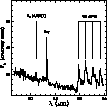The first tests at the telescope took place successfully in early 1994.
From these observations we measured
the efficiency of the instrument (through the observation of
photometric standard stars) and its sensitivity (![]() in 60 s of
integration time); these are reported in Table 2 (click here).
in 60 s of
integration time); these are reported in Table 2 (click here).
| Band(order) | Efficency | Line1 | Continuum2 | ||
| J (I) | 0 | . | 045 | | |
| H (I) | 0 | . | 10 | | |
| K (I) | 0 | . | 08 | | |

Figure 3: Pk2 in Orion, three positions along the slit, with a total
integration time of 60 s

Figure 4: The spectrum of LkHa215 (Ae/Be star) in K band, with a total
integration time of 60 s

Figure 5: Spectrum of the Seyfert 2 NGC 1068
Since January 1996, LonGSp is offered to TIRGO users and employed in several galactic and extragalactic programs. To give an impression of the capabilities of the instrument, we show (in Figs. 3 (click here), 4 (click here) and 5 (click here)) some acquired spectra of various type of sources: extended, compact and extragalactic, without comment as to their astrophysical significance.